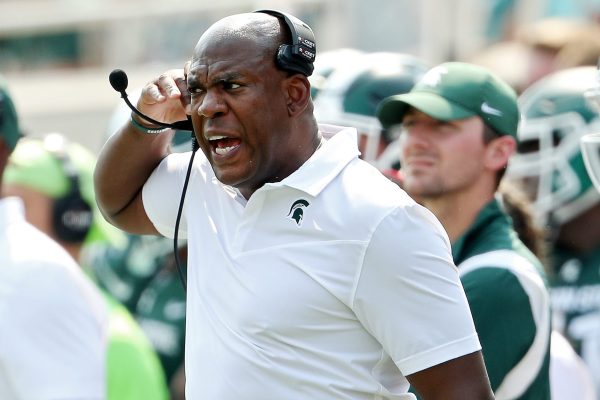College Football’s Massive Amount of Dead Money

It was 1995 when Bobby Bowden became the first million dollar college football head coach. Not long after, rival Florida paid Steve Spurrier double that after the Ole Ball Coach won a national championship in 1996.
Fast forward a couple decades and college football programs are giving head coaches ridiculous amounts of money. It’s almost hard to believe, but some of them are getting huge sums of money NOT to coach. In fact, there’s a pool of almost half a billion dollars in “dead” money, money being paid to college coaches who were fired “without cause.” That’s the politically correct term for you didn’t win enough games.
How did we get here?
Full Tuck
Mel Tucker has been around. He has coached in the NFL, at Ohio State, and even as an assistant to Nick Saban at Alabama. Tucker went 5-7 as the head coach at Colorado, which somehow earned him a new job at Michigan State. In the pandemic-shortened 2020 season, Tucker and the Spartans went 2-5. Then, Sparty found a way to go 11-2 last season and that helped Coach Tuck get a nice contract extension – 10 years, $95 million. Yes, you read that right. An FBS coach who is 18-14 overall will now earn $9.5 million per season.
But, what if it doesn’t pan out? What if the 11-2 season was just a fluke?
The Buyout Clause
Every FBS head coaching contract comes with a buyout clause. It is in the contract to keep a really good coach from moving onto another job. It also gives a university incentive to keep a coach that doesn’t win enough early on in the contract. Typically, the buyout payment is highest in the beginning of a contract and falls as the years go by.
Example. Auburn finally got tired of Gus Malzahn after the 2020 season. Since they fired him “without cause,” the school owed him a buyout … $21.5 million! And don’t forget, Malzahn is the only active FBS coach that has three wins over Saban and Alabama, but Auburn decided to pay him $21.5 million to NOT be the Tigers coach.
New Hire
After a school fires a coach, it has to get a new one. Auburn did that by luring Bryan Harsin from Boise State. The Tigers are paying Harsin $31.5 million – roughly $22 million guaranteed – over six years. That’s over $40 million just to make a coaching change.
Then, there is the issue of the buyout. Take the University of Miami as an example. They fired Manny Diaz and paid him $8 million NOT to be the Hurricanes coach in 2022. The Hurricanes lured alum Mario Cristobal back to South Beach with a 10-year, $80 million contract. Plus, Miami had to pay Oregon the fee – $9 million – for Cristobal ending his contract early.
That is a ton of money. Where is it all coming from?
The Super Booster
In the case of Michigan State, Tuck’s deal comes down to Mat Ishbia and Steve St. Andre. Ishbia was a walk-on for Tom Izzo at MSU when they won the 2000 national title. He owns United Wholesale Mortgage and St. Andre is the CEO of Shift Digital. Both are billionaires. They essentially bought and paid for Coach Tuck.
In Miami, there are plenty of guys like John Ruiz, also a billionaire and an influential Hurricanes booster. Guys like this are opening up the checkbooks for big name coaches because those are the guys that make a difference.
USC

New USC head coach Lincoln Riley
Face it. The once-storied USC Trojans football program has been garbage since the days of Pete Carroll. A $20-plus million buyout bought Clay Helton another year, but USC finally axed Helton and paid him roughly half that amount to NOT coach the Trojans.
Then, the super boosters in southern California got together and ponied up what is believed to be about $110 million for the services of former Oklahoma head coach Lincoln Riley. All Riley did was go 55-10 in five seasons in Norman.
Why pay these guys so much? Well, part of it is simply because they can. Another big part of it is in the form of television media rights. Those contracts continue to explode. Big Ten schools could earn up to $100 million each with a new deal in 2023. That money has to go somewhere.
For Alabama, it’s simply an investment. The school pays Saban roughly $9 million a year, but in return not only does the school get a bunch of national championships, it also has record enrollment rates, campus facility upgrades, and much more.
CompTIA A+ Practice Test Dumps
Dead Money
All told, over the last decade teams from Power 5 conferences have paid out $354.9 million in buyouts, or dead money. Group of 5 schools have paid $62.8 million. That’s over $400 million in dead money. Don’t look for it to stop anytime soon either.
The formula is pretty simple. If the football program is failing, buyout the current coach, find another, pay his buyout, then offer him a long term contract with exorbitant amounts of money. If it doesn’t work out, rinse and repeat.
Consider this. The top 10 highest-paid football coaches at public universities have buyouts in their current contracts that average $35 million! As long as the money keeps flowing in college sports, this vicious dead money cycle will continue.
















